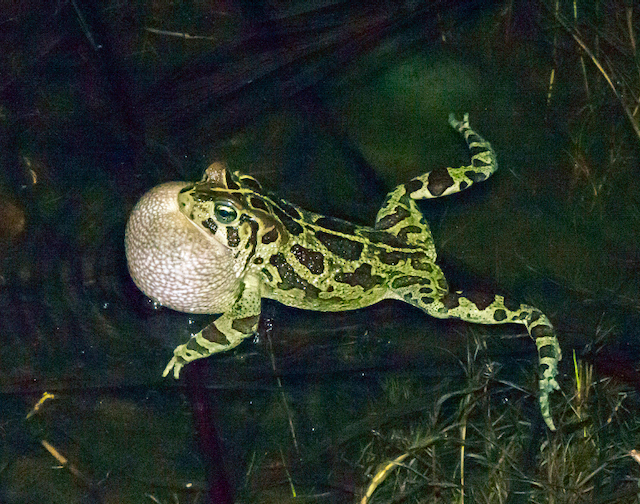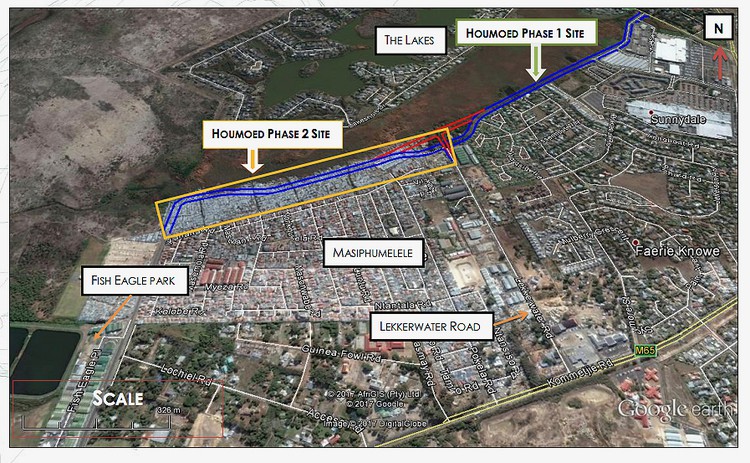It’s “Toad versus Road” in the Cape High Court
Environmentalists challenge road extension that threatens endangered Western Leopard Toads

An endangered Western Leopard Toad calls during the winter breeding season in Skilpadsvlei, Kommetjie. A new Noordhoek road link could drive the species to local extinction, environmentalists warn. Archive photo: John Yeld
- A new road in Noordhoek, Cape Town, could drive the local toad population to extinction, says a group of environmentalists.
- The City of Cape Town acknowledges that there will be some impact.
- But the City says measures can be taken to maintain toad numbers.
- The matter is in court from Wednesday 8 November.
A new section of road through the Noordhoek wetlands could cause the local extinction of the endangered Western Leopard Toad, a keystone species whose presence or absence is an indicator of environmental health – “like the canary in the coal mine”.
This is one of the arguments in an application that starts in the Western Cape High Court on Wednesday 8 November. A local organisation, the Noordhoek Environmental Action Group (NEAG), is challenging both the 2019 Environmental Authorisation (EA) issued for the road and the 2020 dismissal of their appeal against this EA.
The City of Cape Town, the first respondent in the case, acknowledges that the new road will have some “unavoidable” impact on the toads. But it accepts its environmental consultants’ opinion that an “adequate level” of long-term ecological viability for the toad population can be maintained if the road is built, through various measures.
The approval process for this road construction project is described in the voluminous court papers of several thousand pages as an “acrimonious and controversial” affair that has “generated controversy and a complicated record”.
NEAG wants the court to review and rescind approval granted for construction of this 1.2km section of road, known as Houmoed Avenue Extension 1 (HAE1). The section is one part of a planned 2.1km arterial road, Houmoed Avenue Extension, that will link Houmoed Avenue in the west, where it leads off Kommetjie Main Road and terminates in Masiphumelele informal settlement, and Houmoed Avenue in the east that leads off Noordhoek Main Road.
The contested section of new road will run along the south-eastern edge of a wetland of some 50 hectares, commonly called the “Pick ’n Pay reed bed”, where it will impact three known breeding ponds used by the endangered toad.
“It is hard to underplay the importance of the Western Leopard Toad. It is regularly referred to as a ‘flagship’ or ‘umbrella’ or ‘indicator’ species,” NEAG states in its court papers.
“The Pick ’n Pay wetland and its animal inhabitants are already under great pressure. Its existence as a functioning wetland which is a safe place for the Western Leopard Toad and other animals is, without exaggerating, on a knife edge. The road is to be built on a road reserve which was proclaimed many years ago, before environmental concerns were of any importance, certainly before the importance of wetlands and biodiversity were understood and enjoyed the prominence that they have today.”
Masiphumelele
In replying papers, the City points out that Kommetjie Road is one of Cape Town’s top three congestion hotspots. It argues that construction of the new road is “essential” and “a vital intervention to ease traffic congestion in the Kommetjie road network and to integrate, both spatially and commercially, the historically segregated Masiphumelele into the Noordhoek-Kommetjie Valley”.
“The unchecked encroachment of Masiphumelele into the habitat of the Western Leopard Toad represents a far more fundamental threat to the existence of the toad than what will be a permeable roadway on only one of four sides of the wetland.
“The City is, as a result, significantly constrained in its ability to deliver municipal and emergency services to Masiphumelele.”
The Western Cape’s Department of Environmental Affairs and Development Planning approved the HAE1 project in November 2019 when director Zaahir Toefy issued the EA. He is the sixth respondent in the case.
Western Cape Environment MEC Anton Bredell, who in September 2020 refused NEAG’s appeal against the EA, is the second respondent.
The City’s environmental practitioner for the project, Chand Environmental Consultancy, is the third respondent, and the consultancy’s two employees, Ingrid Eggert and Sadia Chand, are fourth and fifth respondents respectively.
Roadkill
In his Heads of Argument, NEAG’s counsel, advocate Murray Bridgman, says the environmental group acknowledges that the presence and influence of Masiphumelele is “large and important”, and notes that it is not challenging that second part of the project, Houmoed Avenue Extension 2 (HAE2).
“It is a matter of record that the wetland adjacent to Masiphumelele is to all intents and purposes ‘dead’,” Bridgman states. “For this reason NEAG and ToadNuts [an associated local specialist toad conservation group] have no objection to the construction of HAE2, the portion of road which is intended to provide a hard boundary between Masiphumelele and the wetland, and [to] end the ever-encroaching shacks on stilts further and further into the wetland.”
He says breeding Pond 2 in particular will be “drastically” affected by HAE1.
“Roadkill will be an enormous factor. Pollution and noise by themselves could destroy Pond 2 as a breeding pond. The effect of the two-and-a-half year construction period is unknown.
“The fact is that the road reserve is only 10 metres wide in most places, sufficient for a small suburban road, but not for the proposed HAE1 which is 20 metres wide and is designed for heavy rush hour traffic.”
NEAG contends that its application can be easily resolved, Bridgman continues, “on the basis of the straightforward fact that there is no expert study on the impact that the construction of the road will have on the Western Leopard Toad”. He calls this omission “a fatal flaw which is incapable of correction”, and argues that it contravenes National Environmental Management Act (NEMA) regulations – “particularly as the Western Leopard Toad is an endangered species”.
“Vital information was not included in the environmental assessment … and vital information was therefore not put before the decision-makers. It is not possible to do an ex post facto expert study.”
Experts
In their Heads of Argument, counsel for the City, advocates Michael Edmunds and Jane Blomkamp, say it is common cause that there is a population of Western Leopard Toads in the affected area and it is probable that these toads breed in one or more of three small ponds in the wetland near the HAE1 route.
But they argue that the potential impact of the project on the toads was indeed flagged as an important issue from the outset of the environmental assessment process, and that toad-related impacts were assessed by two “pre-eminent specialists”, faunal expert Simon Todd and wetland ecologist Dean Ollis, “through the lens of their two different disciplines”.
Both investigations “converged” on several findings and recommendations, some of which are:
- construction of the road could affect the toads through habitat loss, habitat degradation and road mortality;
- the potential impact on toads does not amount to a fatal flaw in the project proposal but should nonetheless be mitigated;
- further necessary mitigation measures will include road design that enables safe passage by toads and toadlets across the road, and concerted efforts to conserve and protect the breeding ponds;
- a landscape architect experienced in rehabilitation and a freshwater ecologist must be involved in conceiving and implementing the rehabilitation plan; and
- an amphibian specialist must be involved in the optimisation of the road design, and for monitoring and reporting on mitigations measures for five years.
“We submit that the specialist studies pertaining to the Western Leopard Toad produced credible findings and recommendations and provided a satisfactory basis for the decisions taken by the Director [Toefy] and the MEC [Bredell],” Edmunds and Blomkamp argue.
“In summary, the deponents have failed to identify a single respect in which the public participation process failed to comply with [environmental] regulations. We submit there is no basis whatsoever for the allegation that the basic assessment process was procedurally unfair.”
A site map of Masiphumelele showing the location of the two phases of the proposed extension to Houmoed Avenue
Letters
Dear Editor
The sentence that said it all is: "Western Cape Environment MEC Anton Bredell, who in September 2020 refused NEAG’s appeal against the EA, is the second respondent." The courts allow appeals as a right, which the province and city administrations regularly use and abuse when it suits them, eg River Club. But they don't allow appeals to genuinely concerning matters because the decisions have already been made, a priori.
In another road dispute - South Road - then Mayco for transport Brett Herron said the City did not have to consult with residents because they knew a priori, without investigation, what was in our best interest. That time too there was a bitter legal dispute. So now because of their intransigence and denial of procedural rights, we have another court case, costing taxpayers, about a controversial planning decision in a long line of them since the DA took power in the city in 2006. (Incidentally, the same know-it-all attitude led to their disastrous miscalculation about the city's water security around 2017.)
Whether or not the City needs another road or development that threatens its biodiversity, like all the other tick-box public participation processes (Chand is the go-to consultant for these), it appears there were allegedly serious flaws in this case that MEC Anton Bredell ought to have considered when appealed. But it's not surprising he didn't give the DA's "red-carpet" approach to development where the green light is given regardless of proven negative impacts. (By the way, he's also known for the irregular "Bredell Cull" and a court case concerning an illegally euthanized Cape Leopard.)
© 2023 GroundUp. This article is licensed under a Creative Commons Attribution-NoDerivatives 4.0 International License.
You may republish this article, so long as you credit the authors and GroundUp, and do not change the text. Please include a link back to the original article.
We put an invisible pixel in the article so that we can count traffic to republishers. All analytics tools are solely on our servers. We do not give our logs to any third party. Logs are deleted after two weeks. We do not use any IP address identifying information except to count regional traffic. We are solely interested in counting hits, not tracking users. If you republish, please do not delete the invisible pixel.



